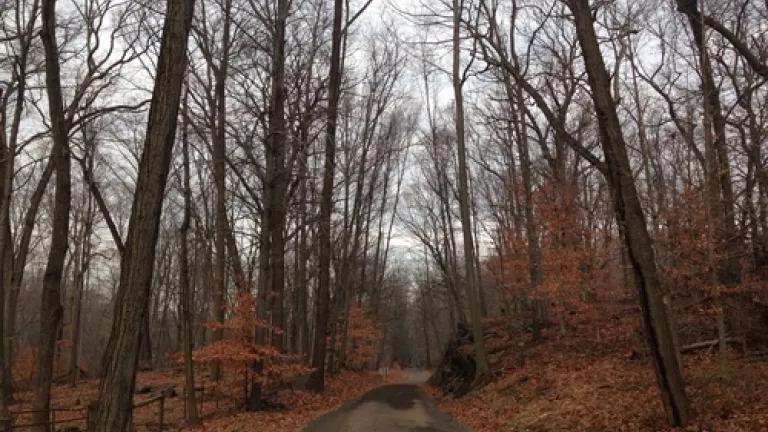
A new report commissioned by the National Wildlife Federation and Southern Environmental Law Center shows once again why it’s critical that we get our biomass policies right. The study finds that exploding demand for wood as fuel in large power plants—driven by government incentives both here and in Europe—threatens some of the most biologically diverse and valuable natural forests in the world. It also drives home the sobering point that without adequate ecological safeguards to guide this growing industry we risk irreversible damage to our Southern forests.
These findings support the conclusions of an earlier report published this year by NRDC and Dogwood Alliance that used Geographical Information Systems (GIS) data layers to show how biomass sourcing by Enviva, the South’s leading exporter of wood pellets, threatens some of our most valuable Southern forests and the multitude of species that depend on them for their habitat. This report itself followed on the heels of a Wall Street Journal investigation [subscription required] that shows that Enviva sources at least some of the wood for this facility from logging companies that clearcut portions of wetland forests in the Mid-Atlantic Coastal ecoregion, some with trees more than 100 years old.
As my colleague discussed here, clearcutting wetland hardwood forests has serious ecological impacts. Forested wetlands play a vital role as anchors for remaining biodiversity across this broad landscape, offering habitat for waterfowl, songbirds, black bear, and a variety of reptiles and amphibians. At the same time, these forests also provide invaluable ecosystem services for communities, including improved water quality, flood storage, and buffering of water flow during drought. They also help us fight climate change by serving as massive “carbon sinks”, sucking carbon out of the atmosphere and storing it safely.
For this latest study, researchers working in partnership across three major Southeastern land grant universities—University of Georgia, University of Florida, and Virginia Tech—examined how biomass sourcing around six biomass facilities in Georgia, North Carolina and Virginia (with sourcing areas stretching into Florida, South Carolina, Tennessee and West Virginia) impacted local wildlife and biodiversity. They found that all of the operations evaluated have the potential to alter wildlife habitat and impact biodiversity in the absence of sustainable sourcing policies. Specifically, they highlighted major risks of conversion away from existing natural forests stands into planted pines—basically giant, monoculture plantations that commonly rely on the routine use of herbicides and chemical fertilizers, and bear little to no resemblance to healthy forests—harvesting of trees in wildlife-rich wetland forests, and uncertain habitat impacts from increased use of residual logging materials.
Spending just a few hours walking through the woods, like I did here in New York last week, is enough to remind you how much forests enhance our quality of life and wellbeing.
Photo: Rockefeller State Park Preserve
Forests are the places where we hike, camp, hunt and fish with our families. They’re home to native animals, plants and other species that will have nowhere to go if their habitats are destroyed. Once a forest is destroyed through industrial logging, its benefits for our communities vanish with it.
Not only that, but we now know that harvesting and burning the highest carbon types of biomass—whole trees—to produce electricity significantly increases carbon emissions, making climate change worse at a time when we need to be rapidly cutting our carbon pollution.
We only have to look to Europe to see the real-world impacts that misguided or flawed biomass policies can have on our forests. Mounting demand for wood in Europe—which lacks adequate biomass sourcing standards and allows wood burning to be counted as “carbon free” under EU climate policies—has led to an explosive growth in biomass energy facilities across the Southern US that are manufacturing wood pellets for export to supply the European electricity market. In 2012, the Southeastern US emerged as the world’s largest exporter of wood pellets for biomass electricity generation. With continued investments throughout the southern US, export volumes reached an estimated 1.75 million tons in 2012 and are expected to jump to 5.7 million tons in 2015, according to the North American Wood Fiber Review.
But while Europe is the most visible consumer of tree-burning biomass energy and European demand for woody biomass from North American forests is growing fast, it’s not just European utilities driving the market for wood pellets. Some of the largest utilities in the US are increasingly turning to tree-burning biomass. Without the right policies to guide the industry, including both sustainable sourcing criteria and sound carbon accounting rules, the massive fuel needs of these energy companies could double logging rates in the Southeast, threatening some of the most biologically-diverse forests in the world and increasing climate pollution. Unfortunately, as the study points out, there are no current policies that require sustainability standards be used for biomass sourcing.
Biomass energy can be clean or very dirty, depending on how and where it is produced. It can be produced in ways that reduce global warming pollution or in ways that increase it. It can help clean up the air, water, and soil and protect wildlife, or it can degrade our lands, forests, and water, threaten biodiversity, and harm public health. Without policies that require that sound sustainability standards be used in biomass sourcing—as well as sound carbon accounting policies to steer the market towards low-carbon sources of biomass and away from whole trees—increased logging of trees for energy production could exacerbate already devastating rates of natural forest conversion, intensive logging of wetland forests, and climate change.
When our natural forests vanish, so do all these benefits they provide. We have to get this right.
